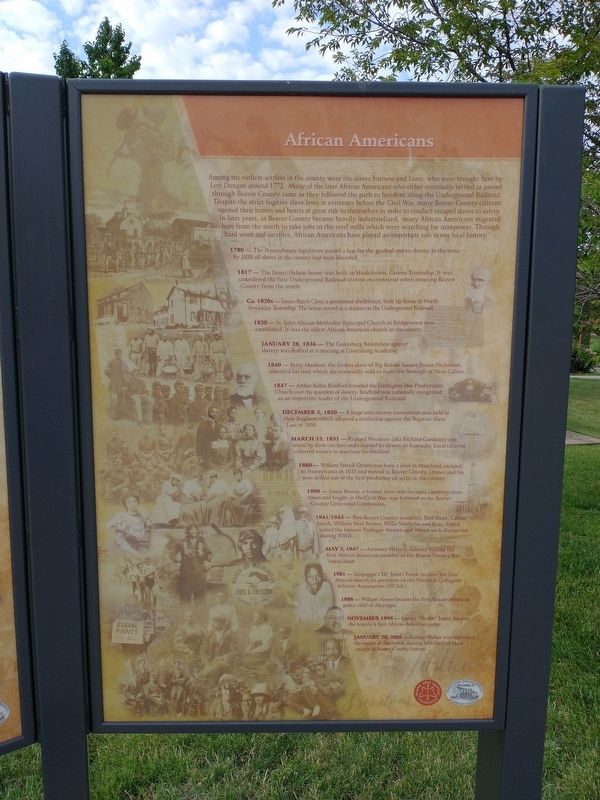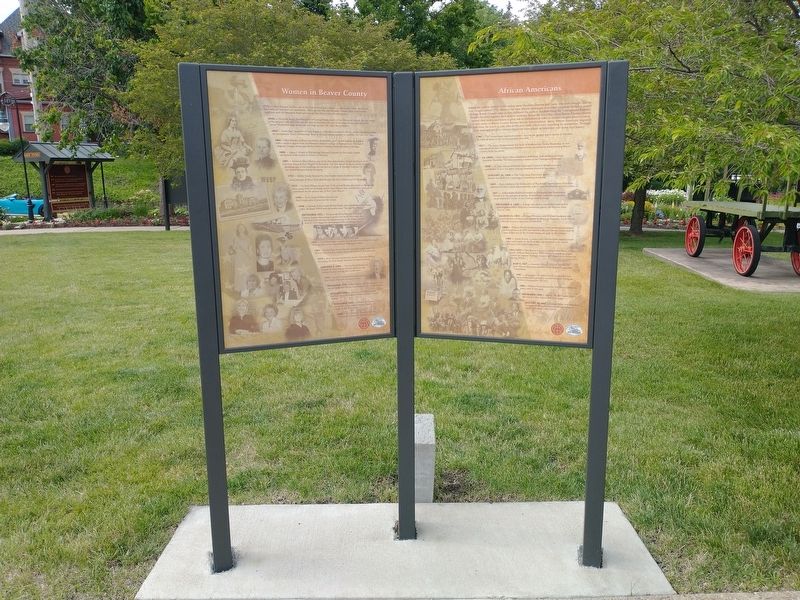African Americans
Among the earliest settlers in the county were the slaves Fortune and Lunn, who were brought here by Levi Dungan around 1772. Many of the later African Americans who either eventually settled or passed through Beaver County came as they followed the path to freedom along the Underground Railroad. Despite the strict fugitive slave laws in existence before the Civil War, many Beaver County citizens opened their homes and hearts at great risk to themselves in order to conduct escaped slaves to safety. In later years, as Beaver County became heavily industrialized, many African Americans migrated here from the south to take jobs in the steel mills which were searching for manpower. Through hard work and sacrifice, African Americans have played an important role in our local history.
1780 - The Pennsylvania legislature passed a law for the gradual end to slavery in the state. By 1830 all slaves in the county had been liberated.
1817 - The James Nelson house was built in Hookstown, Greene Township. It was considered the first Underground Railroad station encountered when entering Beaver County from the south.
Ca. 1820s - James Beach Clow, a prominent abolitionist, built his house in North Sewickley Township. The house served as a station on the Underground Railroad.
1830 – St. John
African Methodist Episcopal Church in Bridgewater was established. It was the oldest African American church in the county.January 28, 1836 - The Greersburg Resolution against slavery was drafted at a meeting at Greersburg Academy.
1840 – Betty Mathers, the former slave of Big Beaver farmer James Nicholson, inherited his land which she eventually sold to form the borough of New Galilee.
1847 - Arthur Bullus Bradford founded the Darlington Free Presbyterian Church over the question of slavery. Bradford was nationally recognized as an important leader of the Underground Railroad.
December 5, 1850 – A large anti-slavery convention was held in New Brighton which adopted a resolution against the Fugitive Slave Law of 1850.
March 13, 1851 - Richard Woodson (aka Richard Gardiner) was seized by slave catchers and returned to slavery in Kentucky. Local citizens collected money to purchase his freedom.
1860 - William Patrick Ormes was born a slave in Maryland, escaped to Pennsylvania in 1835 and moved to Beaver County. Ormes and his sons drilled one of the first producing oil wells in the county.
1900 - James Bruien, a former slave who escaped captivity three times and fought in the Civil War, was honored at the Beaver County Centennial Celebration.
1941/1945 - Five Beaver County residents,
Paul Short, Calvin Smith, William Neal Brown, Willis Sanderlin and Rosa Alford joined the famous Tuskegee Airmen and served with distinction during WWII.May 5, 1947 – Attorney Harry L. Garrett became the first African-American member of the Beaver County Bar Association.
1981 - Aliquippa's Dr. James Frank became the first African-American president of the National Collegiate Athletic Association (NCAA)
1988 - William Alston became the first African-American police chief of Aliquippa.
November 1998 - George "Tookie” James became the county's first African-American judge.
January 20, 2005 - George Walker was appointed the mayor of Rochester, making him the first black mayor in Beaver County history.
Topics and series. This historical marker is listed in these topic lists: Abolition & Underground RR • African Americans • Churches & Religion • Industry & Commerce. In addition, it is included in the African Methodist Episcopal Zion (AME Zion) Church, and the Tuskegee Airmen series lists. A significant historical date for this entry is January 28, 1836.
Location. 40° 41.879′ N, 80° 17.836′ W. Marker is in Beaver, Pennsylvania, in Beaver County. Marker is on East End Avenue just south of 3rd Street (Pennsylvania Route 68), on the right when traveling north.
Other nearby markers. At least 8 other markers are within walking distance of this marker. Women in Beaver County (here, next to this marker); Military Service (here, next to this marker); Famous Athletes (here, next to this marker); Transportation (a few steps from this marker); Properties On The National Register of Historic Places (a few steps from this marker); Labor Movement and Wagner Act (a few steps from this marker); Immigration and Migration Patterns (a few steps from this marker); Growth And Decline 1946-1985 (a few steps from this marker). Touch for a list and map of all markers in Beaver.
Credits. This page was last revised on July 14, 2021. It was originally submitted on July 11, 2021, by Craig Doda of Napoleon, Ohio. This page has been viewed 433 times since then and 68 times this year. Photos: 1, 2. submitted on July 11, 2021, by Craig Doda of Napoleon, Ohio. • Devry Becker Jones was the editor who published this page.

